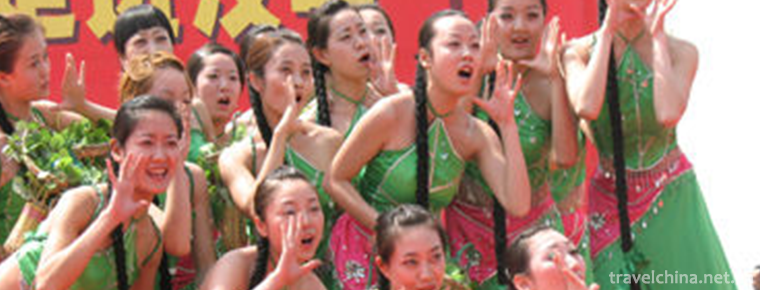2019-03-17

- By ChinaWiki.net
- Chinese Edition
- 2019-07-12
Tiger Sheng of Yi Nationality
Tiger Sheng of Yi nationality is a magical traditional dance of Yi nationality. The Yi people worship tigers and take tigers as totems. It has been said since ancient times that tigers are the people of tigers and the descendants of tigers.
The eighth to fifteenth day of the first month of the lunar calendar is the annual "Tiger Festival", also known as "Tiger Sheng", of the Yi tribe of Dichong Village, Faqin Town, Shuangbai County, Chuxiong Prefecture, Yunnan Province. Tiger Sheng dance form, the ceremony consists of four parts: receiving tiger god, dancing tiger dance, tiger exorcising ghosts and eliminating evil spirits and sending tigers. Its dance forms include 12 sets of tiger dances expressing tiger's living habits and a series of dances expressing productive labor.
The Yi people thought that all things in the world were formed after the death of tigers. Tiger head turns into heaven head, tiger tail turns into tail, tiger skin turns into land, tiger blood turns into galloping rivers, lakes and seas, left eye turns into sun, right eye turns into moon, hardened woods, soft hair turns into grass, muscle turns into fertile land, bone turns into rolling hills and beams. Tiger God is the God of all things and the common ancestor of the Yi people. "Tiger Festival" is to pick up the soul of the tiger ancestor and celebrate the New Year with the Yi people.
On June 7, 2008, the Yi Tiger Sheng was approved by the State Council to be included in the second batch of national intangible cultural heritage list .
Historical Evolution
Tiger Sheng: As early as 6500 years ago, in the legendary Fuxi era, the Qiang people living in the Qinghai-Tibet Plateau and the northwest region created a civilization. Its symbol is the tiger. Later, the descendants of Fuxi gradually migrated to the southwest, hiding in the Yunnan-Guizhou Plateau and southern Sichuan, and evolved into today's Yi and other ethnic groups.
Shuangbai, Yunnan Province, has a Yi tribe called Tiger "Nima". It believes that all things in the world are created by tigers. It thinks that it is the offspring of tigers. It calls itself "NiNi". It is said that in the early years, local Yi leaders should wear tiger skins and wrap tiger skins after death. The eighth to fifteenth day of the first month of the lunar calendar is the annual "Tiger Festival" of the Chongyi tribe of the wheat field in Faqin Town, Shuangbai County, Chuxiong Prefecture, Yunnan Province, also known as "Tiger Sheng". Tiger Sheng dance form, the ceremony consists of four parts: receiving tiger god, dancing tiger dance, tiger exorcising ghosts and eliminating evil spirits and sending tigers. Its dance form includes 12 sets of tiger dances expressing tiger's living habits and a series of dances expressing production and labor.
"Tiger Sheng" Yi ancestors believed that the decomposition of tiger carcasses created all things, forming a unique Yi tiger cosmology. The Yi people worship tigers and respect tigers. They regard tigers as their ancestors and call themselves Ni Ni (tiger in Chinese). That is to say, they call themselves "tiger tribe". Ancient Yi tribal leaders had to wear tiger skins. After their death, they were cremated with tiger skins, indicating that they were born as tigers and turned into tigers after their death. When the Yi people hold ancestor worship ceremonies, a gourd ladle hangs on the gate, its convex face is painted red, and its head is painted black tiger, to show that the family is the descendant of the tiger. Tiger Sheng of Shuangbai Yi nationality is a living historical material of the totem of tiger of Yi nationality. It is simple and primitive, with strong national style. It is not only a sacrificial dance, but also a dance with strong self-entertainment. The wheat Dichong village of Fajian Town is the birthplace of Tiger Sheng.
Relevant Legends
Legend has it that in ancient times, there was an immortal with a huge stone on his back to block the flooding river. When he passed through the wheat fields, the East was white and the sky was getting brighter. The immortal would appear as it is. Unable to walk, he divided the big stones into several pieces and threw them near Maidichong, turning them into three stone gates. The immortals were also at both ends of the village, turning them into two stone tigers, guarding the wheat field. From then on, the Yi people here live and work in peace and contentment, the bad people dare not enter, the devil dare not enter, all the year round the weather is smooth, six animals are safe. In order to thank the two stone tigers and to worship their ancestors, people imitate the tiger's movements and dance tiger dance according to the tiger's habits and hobbies. In the long process of social history, through continuous inheritance and development, a set of sacrificial dances and activities in the form of tiger jumping has gradually formed. Every year from the eighth to fifteenth day of the first lunar month, Dichong wheat holds an eight-day "Tiger Festival", during which there is a complete set of procedures for "offering sacrifices to tigers", "receiving tigers", "jumping tigers" and "sending tigers". On the eighth day of the first month, "pick up the tiger ancestor" and on the fifteenth day of the first month, "send the tiger ancestor". During this period, Tiger Dancing, offering sacrifices to the ancestors of tigers, praying for disaster relief, and sharing happiness with the whole family.
Stylistic features
Tiger jumpers tie their black blankets into tiger skins with tiger ears and tails and drape them over their shoulders. The face, hands and feet were painted with black, red, purple, white and other pigments on the tiger pattern, dressed as a tiger. Tiger Dance, Tiger Team in the gong and sheepskin drum accompanied by the entrance of Tiger Totem Dance. "Tiger opens the door", "Tiger goes out of the mountain", "Tiger beckons", "Tiger catches food", "Tiger bridges", "Tiger contacts relatives", "Tiger mating" (sexual intercourse), "Tiger domesticates cattle farmland", "Tiger raking field", "Tiger sowing", "Tiger seedling", "Tiger harvesting" and other dance movements.

Ask a Question
Your email address will not be published.



0 Questions